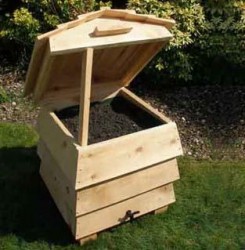Do you know what vermicomposting is? It is a method of composting that uses worms instead of relying solely on bacteria to decompose what’s in the composter. It is fast, efficient, very beneficial for the garden, and a superb way of recycling waste matter for the eco friendly house.
Three ingredients required for any successful wormery are the wormery container, composting materials, and the worms themselves.
As far as wormery containers are concerned, they can be purchased commercially. But why buy a product when items around the house can be recycled and reused to make housing for the worms? Several different types of old containers work including old wooden boxes with lids, plastic buckets and rectangular Styrofoam coolers. Large outdoor garbage cans are excellent for wormeries and they’re easy to handle. Worms aren’t particular about the type of container in which they’re placed as long as they’re in a temperature between 55-77 degrees Fahrenheit, they have food, and have a moist environment.
When using an old garbage can (or some other plastic container) the first step is to drill holes around the top for ventilation and then around the bottom for drainage. The can will need to be set securely upon bricks or blocks and a drainage pan placed under it to catch the organic worm “tea” that is full of nutrients (although if there is dirt under the wormery and near other garden plants you can just let it seep into the ground). Taps and faucets can be added if desired to drain the liquid that collects at the bottom but this isn’t really necessary. The garbage can will need to have a tight fitting lid to keep insects and other critters away and to reduce odors.
The second ingredient for a successful wormery is the worm composting materials. The bottom of the can needs about 2-4 inches of gravel, which should then be covered with something permeable to separate them from the soil layer. This makes harvesting time easier by preventing the mixing of gravel when the worm castings are removed. Appropriate materials include old carpet, fine wire mesh that won’t rust or any weed barrier cloth. Next, about 4 inches of soil needs to be added and covered with wet newspaper and moss. Kitchen scraps like fruits, vegetables, crushed eggshells, and coffee grounds along with grass clippings and leaves can be added. Meat, dairy products, fatty foods, and animal manure should be avoided because they take too long to break down, attract too many insects and cause quite a stench. Next, another layer of moist newspaper strips should be added and then it’s time to add the worms.
The third ingredient for a successful wormery is the correct kind of worms. Earthworms don’t do very well in wormeries but red worms and tiger worms do. About 1000 worms will be needed. These can be purchased at local bait stores or ordered online. It will generally take 2-3 months for the first harvest.
There you have it–the ingredients for making super nutritious vermicompost for your garden. The wormery is a quiet, clean way of recycling and reusing, while the environment and our gardens reap the benefits.


















